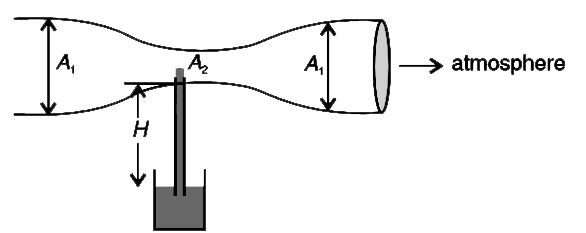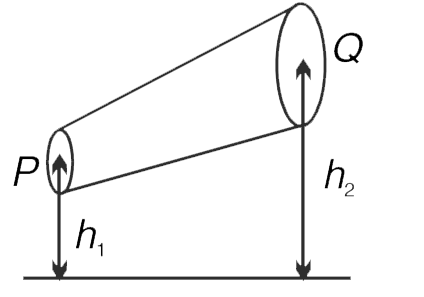Water is flowing through two pipes having constrictions at A and B. The manometric levels in the tubes P, Q, R and S are as shown in the figure. Then

both figures are correct
both figures are wrong
figure 1 is correct and figure 2 is wrong
figure 1 is wrong and figure 2 is correct
The correct Answer is:A
Figure 1 is correct because as per principle of continuity Av=constant. At the constrictions A or B area is very small and hence the velocity of the flow of the liquid is very large and by Bernouli's theorem P+1ev2=constant, and the pressure will be less. Hence the manometric level will be low. Thus figure 1 is correct.In fig. (2), the liquid level in S should be less than that in R.
Topper's Solved these Questions
- BOOK - MARVEL PUBLICATIONCHAPTER - FRICTIONAL IN SOLIDS AND LIQUIDS EXERCISE - TEST YOUR GRASP10videos
FRICTIONAL IN SOLIDS AND LIQUIDS
- BOOK - MARVEL PUBLICATIONCHAPTER - FORCE, WORK AND TORQUEEXERCISE - TEST YOUR GRASP10videos
FORCE, WORK AND TORQUE
- BOOK - MARVEL PUBLICATIONCHAPTER - MAGNETIC EFFECT OF ELECTRIC CURRENT EXERCISE - TEST YOUR GRASP10videos
MAGNETIC EFFECT OF ELECTRIC CURRENT
Similar Questions
Knowledge Check
- Question 1 - Select One
Water flowing through a horizontal pipe line having a constriction. Then,
Apressure will be the same througghlut the length of the pipe.Bpressure will be greater at the constiction.Cpressuce will be smaller in the wider portion.Dpressure will smaller at the constriction. - Question 2 - Select One
Water is flowing through a horizontal pipe of non-uniform cross- section. At the extreme narrow portion of the pipe, the water will have
AMaximum speed and least pressureBMaximum pressure and least speedCBoth pressure and speed maximumDBoth pressure special least - Question 3 - Select One
Water is flowing through a tube of radius r with a speed v. If this tube is joined to another tube of radius r/2, what is the speed of water in the second tube?
Av/4Bv/2C2vD4v
A liquid is flowing through horizonatal pipes as shown in figure.
 View Solution
View Solution(i) Air (density=ρ) flows through a horizontal venturi tube that discharges to the atmosphere. The area of cross section of the tube is A1 and at the constriction it is A2. The constriction is connected to a water (density=ρ0) tank through a vertical pipe of lenght H. Find the volume flow rate (Q) of the air through tube that is needed to just draw the water into the tube.

(ii) A non viscous liquid of constant density ρ flows in a stremline motion along a tube of variable cross section. The tube is kept inclined in the vertical plane as shown in the figure. The area of cross section of the tube at two points P and Q at heights of h1 and h2 are respectively A1 and A2. The velocity of the liquid at point P is v. Find the work done on a small volume ΔV of fluid by the neighbouring fluid as the small volume moves from P to Q.
 View Solution
View SolutionWater is flowing through a tube of radius r with a speed v. If this tube is joined to another tube of radius r/2, what is the speed of water in the second tube?
View SolutionWater is flowing through two horizontal pipes of different diameters which are connected together. The diameters of the two pipes are 3 cm and 6 cm respectively. If the speed of water in the narrower tube is 4ms−1. Then the speed of water in the wider tube is
View SolutionWater is flowing through two horizontal pipes of different diameters which are connected together. The diameters of the two pipes are 3 cm and 6 cm respectively. If the speed of water in the narrower tube is 4ms−1. Then the speed of water in the wider tube is
View Solution

